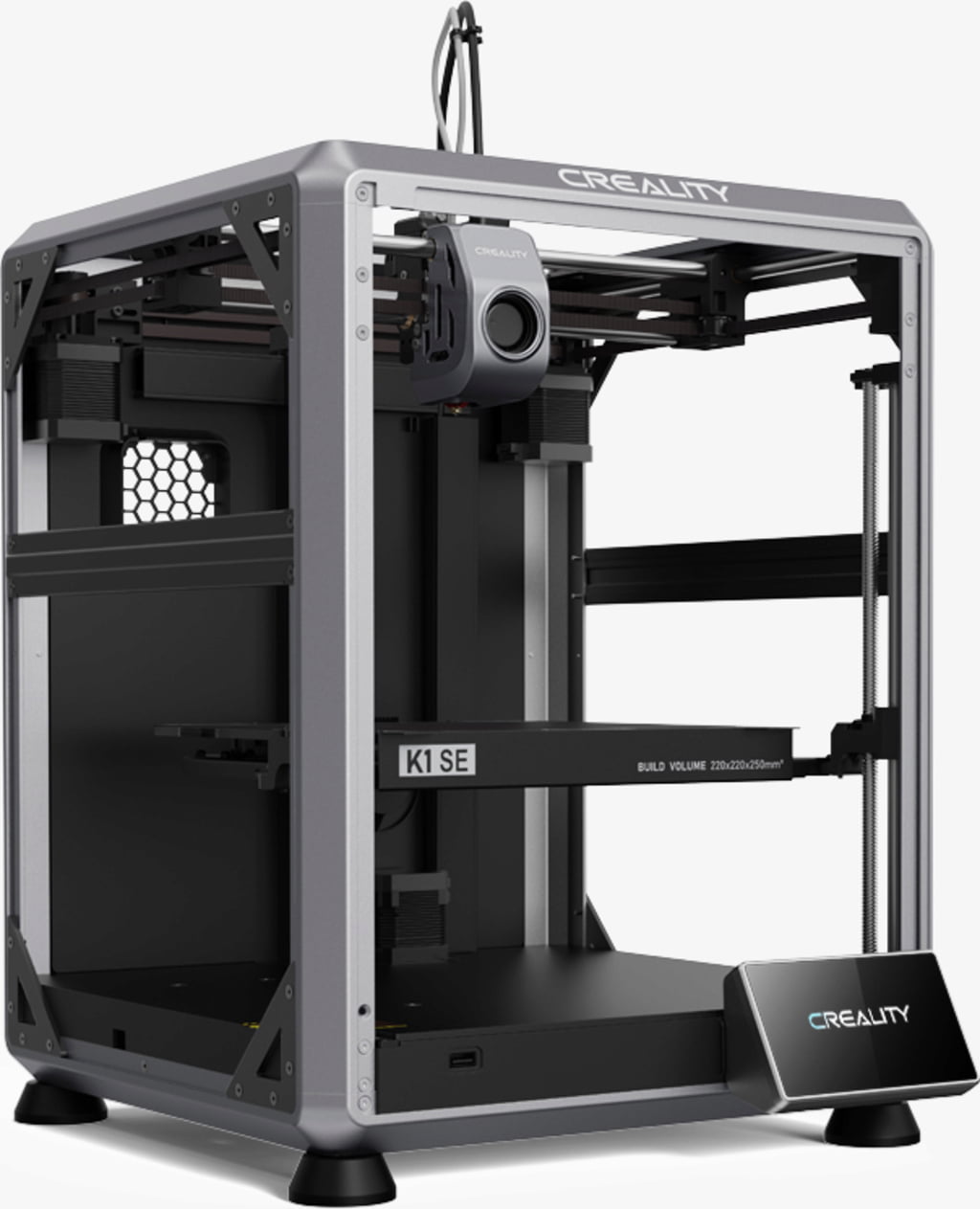Compare K1 SE vs K1 Max
Comparison between the best 3D printers
Choose the best 3D printer at the best price. The cheapest 3D printers are here.
Buy a 3D printer here with 3D Fila.
 |
 |
|
| Model | K1 SE |
K1 Max[BUY K1 Max] |
| Printing Material | Filament | Filament |
| Buy Filament for Creality 3D K1 SE | Buy Filament forCreality 3D K1 Max | |
| Estimated price | $349,00 | $1300,00 |
| Manufacturer | Creality 3D | Creality 3D |
| Release Year | 2023 | 2023 |
| Print Volume [mm] | 220x220x250 | 300x300x300 |
| Printer Size [mm] | 355x355x480 | 435x462x526 |
| Weight [kg] | 10,24 | 18 |
| Power Loss Recovery | YES | YES |
| Enclosed printer | NO | YES |
| Bed Leveling | Automatic | Automatic |
| Filament End Sensor | YES | YES |
| Bed type | Heated | Heated |
| Power supply system | Direct Drive | Direct Drive |
| Standard nozzle | 0,4 | 0,4 |
| Maximum Nozzle Temperature [°C] | 300 | 300 |
| Maximum Bed Temperature [°C] | 100 | 100 |
| Maximum printing speed [mm/s] | 600 | 600 |
| Filament holder | YES | YES |
| Camera for supervision | YES | YES |
| Recommended filaments | Hyper PLA, PLA, PETG, PET, TPU | ABS, PLA, PETG, TPU, PA, ASA, PC, PLA-CF, PA-CF, PET-CF |
| Recommended slicers | Creality Print; Cura, Simplify3D e PrusaSlicer | Creality Print, Cura, Simplify, Slic3r, IdeaMaker e outros |
| Maximum Resolution [mm] | 0,1 | 0,1 |
| Processor | ||
| Display | Display touchscreen 4,3'' | Display touchscreen 4,3'' |
| Power Supply | 110/220V / 350W | |
| Connectivity | Ethernet / USB / Wi-Fi | USB / Wi-Fi / Ethernet |
| Operating systems | Windows, Mac, Linux | Windows, Mac, Linux |
| Date of registration in the system | 2023-08-26 | 2023-12-01 |
| Release date | 2023 | 2023 |
| Extra features | The Creality K1 SE is a high-speed 3D printer with CoreXY system, capable of printing at up to 600mm/s with acceleration of 20000mm/s². It has a dual-gear extruder, easy-to-replace tri-metal nozzle, automatic leveling, and advanced features such as vibration reduction algorithms and intelligent operation. Its rigid cast aluminum frame ensures stability, while the open-source Klipper-based system offers freedom for customization. It is pre-assembled for a simplified and fast user experience. | The Creality K1 Max stands out as a fast Core XY 3D printer with a large build volume of 300 x 300 x 300 mm. It is fully enclosed and equipped with AI sensors to prevent print failures. This model has a smooth and flexible PEI build platform, and uses an automatic leveling system with LIDAR, as well as a filament run-out sensor. LAN, Creality Cloud and USB Flash Disk connectivity are available, as well as a 4.3-inch touchscreen interface. The K1 Max is robust, weighing in at 18 kg, and includes an AI camera and limited version of the Klipper firmware. Its motion system is solid and the printer is efficient with high-temperature filaments, but it is not silent. Assembly is 99% complete, requiring only minor adjustments before use. |
| Support for multiple colors and materials (AMS and CFS) | NO | NO |
Notes * |
||
| Cost-benefit | 7 / 10 | 7 / 10 |
| Hardware | 3.5 / 10 | 4.2 / 10 |
| Tela | . | . |
| Print volume | 3 / 10 | 4 / 10 |
| Performance | 5 / 10 | 5 / 10 |
| [BUY K1 Max] |
Conclusion |
| In conclusion, the comparison between the Creality K1 SE and the K1 Max highlights distinct strengths and weaknesses suited for different user needs and budgets. The K1 SE offers a more accessible price point while still delivering impressive performance, including high-speed printing capabilities up to 600 mm/s and a well-designed CoreXY system. Its features, such as automatic leveling and a dual-gear extruder, make it a great choice for enthusiasts and those looking to get into 3D printing without a significant investment. However, it has a smaller print volume and lacks an enclosed build chamber, which may limit its versatility in handling certain materials, particularly high-temperature filaments. On the other hand, the K1 Max, though significantly more expensive, elevates the 3D printing experience with a larger build volume and an enclosed design that enhances printing stability and material compatibility. It incorporates advanced features like AI sensors and an automatic leveling system with LIDAR, ideal for more demanding projects and users who prioritize reliability and precision. However, it does come at a higher cost, which may not be justified for casual users or those with simpler printing needs. Both models excel in performance and speed, receiving equal scores in terms of performance metrics, but individuals must weigh the advantages of larger capacity and advanced features against their specific printing requirements and budget constraints when making a choice. Overall, whether one opts for the K1 SE or the K1 Max, each printer stands out as a strong contender in the current market, catering to distinct segments of 3D printing enthusiasts. |

